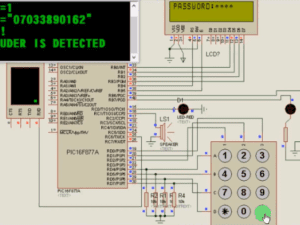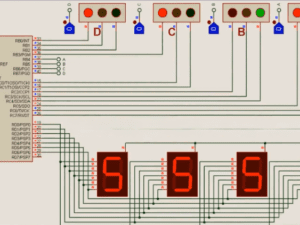Traffic light with GSM Density checker using PIC16F877A
- Description
- Curriculum


Are you a final-year engineering student or a tech hobbyist eager to create innovative traffic management systems? Our comprehensive course, “Traffic Light with GSM Density Checker Using PIC16F877A,” is designed to teach you how to design, program, and simulate a state-of-the-art traffic light system with density checking capabilities using Mikro C and Proteus IDE from scratch.
In this hands-on course, you will learn to develop a smart traffic light system that can dynamically manage traffic flow based on real-time density data received via GSM. This project not only adds significant value to your portfolio but also equips you with practical skills in microcontroller programming and embedded systems, essential for tackling real-world engineering challenges.
What You’ll Learn:
- General Overview of Traffic Light with GSM Density Checker Using PIC16F877A: Understand the concept, components, and real-world applications of a GSM-based traffic density checker integrated with a traffic light system.
- Creating and Saving Your Project: Step-by-step guidance on setting up and saving your project in Proteus and Mikro C.
- Program Initialization: Learn how to initialize your program for efficient execution.
- Tracking Special Symbols From Incoming Data: Techniques to interpret and process data received via GSM.
- Enabling PortB Internal Interrupt: Set up internal interrupts for effective signal processing.
- Removing Empty Spaces Between Received Data: Clean and format incoming data for accurate processing.
- AT Commands For SMS: Use AT commands to send and receive SMS alerts.
- Displaying Traffic Density at Lane A: Implement and display traffic density data for lane A.
- Displaying Traffic Density at Lane B: Implement and display traffic density data for lane B.
- Displaying Traffic Density at Lane C: Implement and display traffic density data for lane C.
- Displaying Traffic Density at Lane D: Implement and display traffic density data for lane D.
- General System Initialization: Properly initialize the entire traffic light system.
- Final Project Code: Compile the final code for the complete project.
- Code Review: Review and optimize your code for better performance.
- Project Compilation and Simulation: Finalize your project and simulate it in Proteus to ensure everything works perfectly.
Real-World Usefulness and Smartness:
- Efficient Traffic Management: Dynamically manage traffic flow based on real-time data, reducing congestion and improving road safety.
- GSM Integration: Utilize GSM technology to receive and process traffic density data, making the system more adaptive and intelligent.
- Scalable Solution: Easily scalable to accommodate more lanes or integrate with larger traffic management systems.
- Energy Efficiency: Optimize traffic light cycles to reduce energy consumption and enhance efficiency.
Benefits of Taking This Course:
- Comprehensive Learning: Covers every aspect of designing and simulating a GSM-integrated traffic light system.
- Hands-On Experience: Engage in practical exercises that provide real-world skills.
- Expert Guidance: Learn from experienced instructors with clear, step-by-step explanations.
- Career Advancement: Enhance your skills and make yourself a valuable candidate for tech and engineering roles.
- Innovative Project: Work on a project that you can showcase in your portfolio and stand out to potential employers.
Why Choose This Course:
- Beginner-Friendly: Designed for those with no prior experience in microcontroller programming.
- Detailed Explanations: Thorough explanations and practical examples to ensure you understand every concept.
- Interactive Learning: Hands-on projects and simulations to apply what you learn.
- High-Quality Content: Professionally developed curriculum for the best learning experience.
- Community Support: Join a community of learners and get support when you need it.
Intended Audience:
- Final Year Engineering Students: Ideal for students working on their final year projects.
- Tech Hobbyists: Perfect for hobbyists interested in traffic management and microcontroller projects.
- Aspiring Engineers: Those looking to enhance their skills and knowledge in embedded systems and microcontroller programming.
Course Requirements:
- Basic Computer Skills: Familiarity with using a computer and navigating software.
- Proteus IDE: Installation of Proteus IDE for circuit design and simulation.
- Mikro C Pro for PIC: Installation of Mikro C Pro for PIC for programming.
- Basic Electronics Knowledge: Understanding of basic electronic components and circuits.
- Curiosity and Enthusiasm: A desire to learn and create innovative traffic management systems.
Enroll in “Traffic Light with GSM Density Checker Using PIC16F877A” today and start your journey towards mastering microcontroller programming and smart traffic solutions!
-
2General Overview of Traffic light with GSM Density checker using PIC16F877A
-
3Creating And Saving Your Project
-
4Program Initialization
-
5Tracking Special Symbols From Incoming Data
-
6Enabling PortB Internal Interrupt
-
7Removing Empty Spaces Between Received Data
-
8AT Commands For SMS
-
9Displaying Traffic Density At Lane A
-
10Traffic Density At Lane B, Lane C And Lane D
-
11General System Initialization
-
12Final Project Code
-
13Code Review
-
14Project Compilation and Simulation





